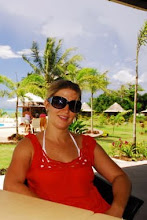The following article was published last Saturday in the American Samoa News and the Western Samoa News. I wrote the paragraph on the NOAA internship program:
ASCC Marine Science Internships Facilitate Hands-on Learning
ASCC Press Release
July 19, 2008
Anyone involved in the sciences, or any of the professions based largely on activity, will tell you that theory will only take you so far without practice. At the American Samoa Community College (ASCC), the Marine Science program seeks to close the gap between theory and practice through internship programs. According to Lauren Wetzell, ASCC Marine Science instructor, “Internship opportunities, where students learn through hands-on experiences, help bridge a gap between academia and the working world. Internships also help them develop skills they can use in future employment. As students follow their interests and apply their skills, they get a sense of whether they might want to pursue a certain career path. During their internships, students build relationships and develop a network of professionals who may assist them in further career development.”
As an example of a student whose experience as an intern enabled him to turn his educational goals into a professional career, University of Hawaii Sea Grant College Program Junior Extension Agent Ephraim Temple refers to recent graduate Francis Leiato. “Francis graduated this past June with a double major in Marine Science and Liberal Arts,” said Temple, “and thanks to his experiences as an intern, he now has a job pursuing his area of interest.” Leiato participated in several internships during his years at ASCC. The Hawaii Institute of Marine Biology (HIMB) funded the most recent of these, through a University of Hawaii partnership with the National Marine Sanctuaries Program-Pacific Region and support from ASCC and UH Sea Grant. Leiato and four other students worked with HIMB researcher Scott Godwin, studying the various groups of marine invertebrates, such as sponges, corals, hydroids, and anemones. They then put their newly acquired scientific training to work here at home by conducting surveys of reef flats in Auto, Asili, and Tisa’s Cove. The findings of Leiato and the other students will form the basis of a booklet due for publication later this year which describes native Samoan sea cucumbers. He also participated in a 2006 aquaculture internship sponsored by a National Oceanic and Atmospheric Administration (NOAA) grant awarded to the Pacific Islands Educational Partnership Consortium (PIEPC) to develop faisua farming in American Samoa.
Leiato’s interest in aquaculture (the farming of seafood) eventually led him to successfully apply for a job in the Land Grant/CNR division at ASCC. Today he works at developing an aquaculture demonstration facility for the culture of tilapia and aquarium fish. Local tilapia farmers now use the knowledge passed along by Leiato to produce their own feeds using locally produced products. He works directly with UH Sea Grant extension agent Temple on a number of projects to improve aquaculture capacity in the Territory. “Francis obviously learned valuable academic and job skills from his internship experiences at ASCC. I feel confident in giving him different challenges knowing that he has the practical knowledge of aquaculture systems and can explore and implement solutions on his own,” Temple said. This past June, Leiato received an invitation to represent the ASCC Marine Science department at a National Science Foundation/ Advanced Technological Education-sponsored workshop on coral reef taxonomy held in Palau. Leiato will work with ASCC faculty to integrate information from the workshop into future developments of the College’s Marine Science curriculum.
With the National Oceanic and Atmospheric Administration (NOAA) and the American Samoa Department of Commerce currently exploring the possibility of developing a national marine sanctuaries network in American Samoa, more internship opportunities could soon open up. NOAA will select candidate sites through a process of biological and socioeconomic assessments conducted at coastal sites throughout the American Samoa archipelago. During the preliminary phase of this project, NOAA and DOC will collaborate with ASCC to conduct a socioeconomic analysis of the villages adjacent to the Fagatele Bay National Marine Sanctuary. Emily Gaskin, a NOAA fellow on detail in American Samoa will run the project in collaboration with Seeseei Toa, a Natural Resource Science student at ASCC. Preliminary work on the project includes conducting interviews and distributing surveys to gather information about stakeholders and users, the extent of their use, and local attitudes towards marine conservation. Upon completion of the study, Gaskin and Toa will prepare a report advising NOAA and DOC about socioeconomic variables that could influence the expansion project.
Collaborations between various agencies and the ASCC Marine Science program this fall semester will result in more than 10 new internship opportunities for qualified students, regardless of their major. The collaborating agencies look to a cross-disciplinary field such as Marine Science to find self-motivated, dependable, and career oriented college students to fill these positions. These unique internship opportunities will give students a chance to explore activities that could lead to careers involving the sustainability of marine natural resources. Anyone seeking more information on Marine Science internships should contact Lauren Wetzell, Marine Science Coordinator, or Ephraim Temple, UH Sea Grant Extension Agent, through the main ASCC switchboard at 699-9155 or by emailing e.temple@amsamoa.edu.
http://www.wsamoa.ws/index.php?m=25&s=&i=7916


























































